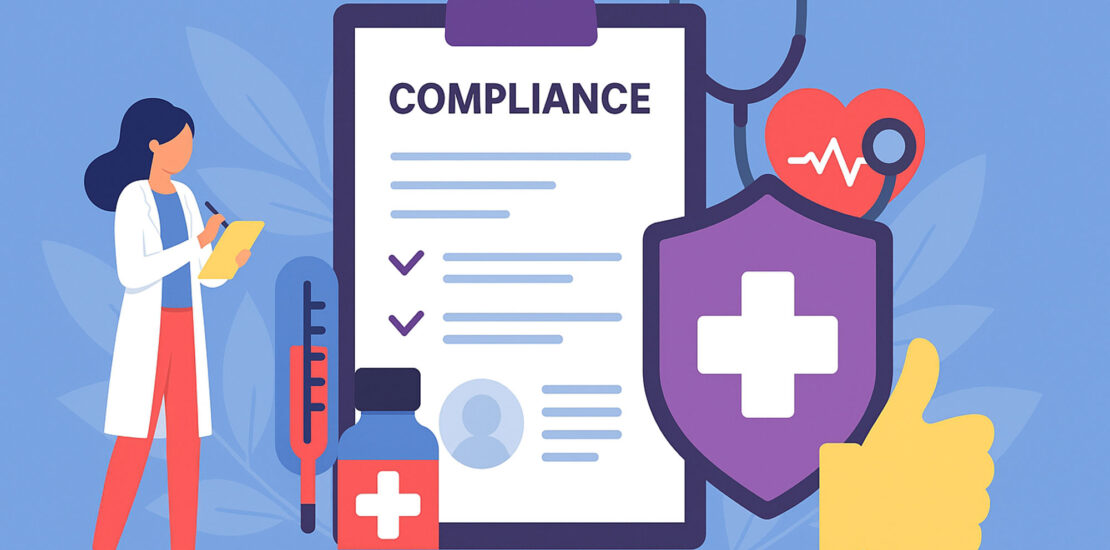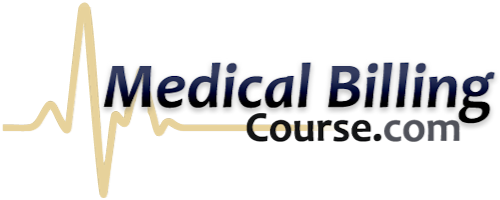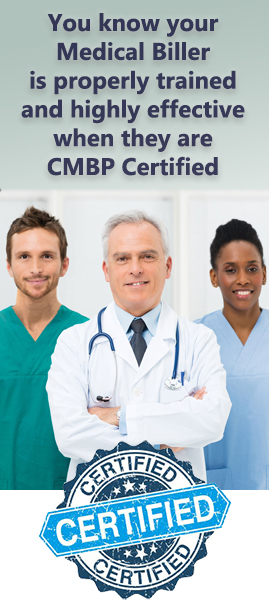- 08/29/2025
- Posted by: Medical Billing Course
- Categories: Medical Billing Compliance, Medical Billing Course

Medical billing compliance is much more than following a checklist or avoiding fines.
At its core, it means every claim sent, every patient record handled, and every dollar billed reflects accuracy, ethical standards, and strict protection of patient data.
For healthcare practices and billing professionals, compliance is the foundation that builds patient trust and keeps revenue cycles moving smoothly.
Mistakes, whether from incorrect coding, privacy oversights, or missed updates to regulations, can lead to heavy penalties, lost revenue, audits, and even practice closures.
Legal risk isn’t just theoretical; every year, enforcement actions make headlines, and practices lose their ability to bill.
This guide breaks down what medical billing compliance really means today, the most important laws and guidelines you need to follow, and the best steps to protect your practice and your career.
Get ready for a practical, in-depth look at compliance that goes far beyond the basics.
Key Areas of Medical Billing Compliance
Medical billing compliance involves several critical areas, each with unique risks and requirements.
Here’s what every biller must know to keep claims accurate, secure, and legal.
a. Accurate Coding and Billing Practices
Accurate coding forms the bedrock of medical billing compliance.
Every claim must use the correct CPT, ICD‑10, and HCPCS codes, as well as adhere to NCCI (National Correct Coding Initiative) edits.
Errors like upcoding (billing for more expensive services than provided), unbundling (charging separately for procedures that should be grouped), or simply using the wrong code can trigger audits, claim denials, and even allegations of fraud.
For example, the Office of Inspector General (OIG) routinely publishes cases where providers face thousands or millions in fines for systematic coding errors or deliberate upcoding.
The Centers for Medicare & Medicaid Services (CMS) also provides strict guidelines and annual updates.
The key: Always double-check coding, follow national and local coverage determinations, and regularly audit claims for errors to ensure legal and financial security.
b. Patient Privacy and Data Security
Patient privacy isn’t just good practice; it’s federal law.
Medical billing compliance requires full adherence to HIPAA (Health Insurance Portability and Accountability Act), HITECH (Health Information Technology for Economic and Clinical Health Act), and sometimes even stricter state regulations.
A single misstep, such as sending PHI (protected health information) to the wrong recipient or failing to secure billing records, can result in fines up to $1.5 million per year per violation (HHS.gov).
Real-world PHI breaches, like those cataloged in the HIPAA Journal, often stem from billing and claims errors: lost paperwork, unsecured emails, or unauthorized access to EHRs.
To go beyond the minimum, practices should encrypt all digital billing data, use secure portals for claims, audit staff access logs, and conduct frequent privacy training.
Compliance isn’t static; proactive privacy protocols are now a must for every billing team.
c. Fraud, Abuse, and Anti-Kickback Laws
Federal laws like the False Claims Act (FCA), Anti-Kickback Statute (AKS), and Stark Law are cornerstones of healthcare billing compliance.
The FCA prohibits knowingly submitting false claims to federal health programs, while the AKS and Stark Law address illegal inducements and self-referrals. “Intent” matters: even reckless disregard for billing accuracy can trigger enforcement.
The Department of Justice (DOJ) collected over $2.9 billion in FCA settlements and judgments in 2024, with healthcare fraud making up the majority (Reuters).
Common violations in billing include billing for non-rendered services, duplicate billing, or accepting gifts for patient referrals.
Safe harbors exist for some arrangements, but any questionable billing practice should be reviewed by a compliance officer or legal counsel.
Providers and billers must know that violations can lead to exclusion from Medicare and Medicaid, criminal prosecution, or financial ruin.
d. Medical Necessity and Documentation
“If it’s not documented, it didn’t happen” is the golden rule for medical necessity in billing.
Every claim must be backed by documentation that clearly supports the service as medically necessary, per CMS and payer rules.
Lack of clear clinical notes or supporting evidence leads to denials, payment recoupments, and sometimes fraud investigations.
TheCMS stresses that documentation must be timely, legible, and comprehensive. Recovery Audit Contractors (RACs) routinely deny claims for insufficient or missing documentation (CMS RAC).
Good documentation links the diagnosis, the clinical decision, and the billed procedure, while bad documentation leaves gaps or uses vague language (“follow-up” without context, for example).
Internal audits and EMR templates can help practices keep pace with these evolving standards.
e. Timely Filing and Claims Submission
Strict deadlines define compliance for claim filing.
Medicare requires most claims to be submitted within one year of the date of service, while private insurers may have even tighter windows.
Missing these deadlines leads to automatic denials and unrecoverable revenue. For example, a busy multi-specialty clinic in Texas lost over $60,000 in one year due to claims not filed on time, most due to paperwork delays and lack of policy awareness.
Appeals windows for denied claims are also short, ranging from 60 to 180 days, depending on the payer.
The only way to avoid revenue loss is to establish airtight workflows, use claims-tracking software, and ensure staff are regularly trained on each payer’s requirements.
f. Audit Preparedness and Risk Management
Compliance is proven not by intention, but by documentation and audit readiness.
Internal audits, using compliance checklists and random sample reviews, help catch issues before an external audit strikes.
The OIG recommends at least annual self-audits, along with response plans for payer or government audits.
Practices should keep organized, complete billing records, maintain detailed EHR audit trails, and respond quickly to all audit requests.
Many private audit firms and compliance consultants offer audit simulation and risk scoring to help identify vulnerabilities.
The best-prepared organizations make audit-readiness a routine part of their compliance program, treating every claim as if it might be examined tomorrow.
g. Ongoing Training and Compliance Updates
Medical billing regulations change constantly: annual CPT and ICD-10 updates, evolving state and federal rules, and shifting payer policies.
CMS and major payers often release multiple bulletins and rule changes each year, impacting everything from telehealth coverage to prior authorization requirements.
Relying on last year’s knowledge puts any practice at risk. Ongoing training and real-time policy reviews are essential.
This is where structured education, like Medical Billing Course, becomes invaluable. The courses are updated to reflect the latest compliance laws, software best practices, and audit preparation skills, equipping billers to respond quickly and confidently to regulatory change.
h. Ethical Billing Standards
Compliance is more than just obeying the law; it’s about maintaining transparency and fairness in every billing interaction.
This includes honest communication about costs, prompt correction of errors, and swift refunds of any overpayments.
Recent coverage in media and resources highlights that many compliance “gray areas,” such as questionable upcoding or aggressive balance billing, often arise from rushed or poorly supervised workflows.
Billers should not be afraid to ask questions, flag unusual requests, or speak up about policies that seem at odds with both the law and best practices.
In the current climate, patients and payers expect honesty, transparency, and corrective action, not just technical compliance.
Why Medical Billing Compliance Matters

Compliance in medical billing isn’t optional.
Mistakes or intentional noncompliance can lead to devastating consequences, many of which affect both the financial stability and reputation of healthcare providers.
Real Consequences: Fines, Exclusion, Criminal Penalties, and Practice Closure
Violations under the False Claims Act may cost anywhere from $14,308 to $28,619 per false claim, adjusted annually for inflation. When submitted claims number in the thousands, penalties can escalate to millions of dollars in civil fines, plus treble damages and repayment of the government’s costs.
Criminal penalties are equally serious: individuals convicted under the FCA may face up to five years in prison and fines up to $250,000, while businesses might pay fines reaching $500,000 (Stanley Friedman Law).
Physicians or billers found in violation of the Stark Law or the Anti-Kickback Statute can face exclusion from Medicare and Medicaid programs, refunds of inappropriate payments, and substantial civil penalties of up to $15,000 per service, or even $100,000 for coordinated schemes involving circumvention.
Table of Common Violations and Fines
| Violation Type | Penalties |
| False Claims Act | $14K–$28K per false claim + treble damages, plus removal from federal health programs |
| HIPAA Privacy Breach | $100–$50,000 per violation; max $1.5M/year; criminal penalties up to $250K and imprisonment |
| Stark Law Violation | $15K per referral + repayment; exclusion from Medicare & Medicaid |
| Anti-Kickback Statute Violation | Civil penalties, criminal fines, and program exclusion |
Operational Impact: Lost Revenue, Audit Burden, and Contract Termination
Noncompliant billing often leads to claim denials and revenue delays. Practices face payer recollection, slowed reimbursement cycles, and increased administrative burden.
For example, internal audits can interrupt normal workflows, divert staff time, and reduce efficiency across billing, front desk, and clinical teams.
Reputation matters: frequent denials or violations under medical billing audit compliance erode patient trust.
It also affects contracts with insurers; payors may terminate agreements or demand refunds if audits reveal systematic billing issues.
CMS or OIG audits following whistleblower investigations can force entire organizations to revamp billing operations or face closure.
The Difference Between Compliant and Non-Compliant Practices
Compliant practices maintain updated coding protocols, secure PHI handling, robust audit systems, continuous staff training, and transparent documentation workflows.
Non-compliance often results from outdated policies, inconsistent coding, unsecured data, and a lack of training.
The difference can mean surviving and thriving, or being shut down.
Clean compliance enables smoother audits, faster reimbursements, and stronger payer relationships.
Breach findings and repeated audits can drag a practice into costly remediation, diminished reimbursement, and eroded patient confidence.
Medical Billing Compliance Regulations: Keeping Up with Change
Medical billing regulations are not static. They’re revised and expanded every year, driven by changes in federal law, payer rules, and industry oversight.
Staying current is essential to avoid errors, denials, or costly penalties.
How Often Do Medical Billing Regulations Change?
- Coding Updates: The American Medical Association (AMA) releases new CPT codes and revisions annually. ICD-10 code updates from the CMS also occur every year, typically taking effect on October 1 (CMS ICD-10 Updates). For example, the 2024 ICD-10-CM update added 395 new codes and revised 13.
- HIPAA Rule Changes: The Department of Health and Human Services (HHS) regularly proposes or finalizes updates to HIPAA rules. In 2024, HHS finalized major changes to the HIPAA Privacy Rule, including enhanced patient access to records and restrictions on the use of reproductive health data.
- Price Transparency & Surprise Billing: The No Surprises Act went into effect in 2022, banning many out-of-network surprise bills and creating new requirements for cost disclosures (CMS No Surprises Act). Price transparency rules now require hospitals and insurers to publicly post negotiated rates and cost estimates for common procedures (CMS Price Transparency).
Timeline: Major Regulatory Updates (2023–2025)
| Date | Update | Source & Impact |
| Oct 2023 | ICD-10 & CPT Annual Update | CMS – hundreds of new and revised codes; impacts claims accuracy |
| April 2024 | HIPAA Privacy Rule Revisions | HHS – expanded patient rights, privacy requirements |
| 2022–2025 | No Surprises Act & Price Transparency Laws | CMS – mandatory estimates, out-of-network billing limits |
| Jan 2025 | Prior Authorization API Mandate | CMS Proposed Rule – payers required to use ePA (electronic prior authorization) for certain services |
Building Compliance Confidence: Your Next Steps in Medical Billing
Success in medical billing compliance is a result of using reliable tools, choosing trustworthy resources, and making ongoing education part of your routine.
The strongest organizations blend technology, like EHR platforms with audit features and proven compliance software, with regular use of official checklists from agencies such as CMS and OIG.
What sets true compliance leaders apart is knowing where to turn for clear answers: government guidelines, established industry groups, and experienced educators, rather than rumors or vendor marketing.
But even the best tools can’t replace what matters most: a team that trains regularly, reviews its own work, and treats compliance as an everyday priority.
Updating written policies, running mock audits, and keeping up with regulatory news are the habits that prevent costly errors and build lasting trust with patients and payers.
For anyone ready to make compliance second nature, structured learning, like the programs offered by Medical Billing Course, provides up-to-date curriculum, hands-on software practice, audit simulations, and ongoing updates for every major regulation.
This kind of preparation doesn’t just reduce risk; it makes you the biller or practice that payers want to work with.
Action today means security tomorrow:
- Review your current policies
- Start internal audits
- Sign up for compliance-focused training
- Use only trusted, official resources for every workflow change
In medical billing, the difference between barely keeping up and truly thriving is simple: treat compliance as your competitive advantage, not just a box to check.
And when you’re ready for step-by-step, audit-ready mastery, the right educational partner can help you lead the way.
Medical Billing Compliance FAQs: Key Areas & Best Practices
What are the key compliance areas in medical billing?
Key areas include accurate coding and billing, patient privacy (HIPAA), fraud prevention, proper documentation, timely claim submission, audit preparedness, ongoing training, and ethical billing. Each requires up-to-date policies and regular reviews to avoid legal and financial risks.
Why is medical billing compliance crucial for healthcare practices?
Compliance prevents legal penalties, audit disruptions, and claim denials. It safeguards a practice’s reputation, ensures steady revenue, and builds trust with patients and insurers. Strong compliance also protects practices from exclusion by payers and regulatory bodies.
What are the consequences of non-compliance in medical billing?
Non-compliance can result in fines, repayment demands, exclusion from Medicare/Medicaid, criminal charges, and reputational damage. Practices may also face audit burdens, operational disruptions, and loss of contracts with insurers or government programs.
How often do medical billing regulations change?
Regulations are updated annually: CPT, ICD-10, and payer rules change every year. Additional changes may occur with new laws, CMS or OIG guidance, and emerging technologies, requiring ongoing education and frequent policy reviews.
What resources are available for staying compliant in medical billing?
Trusted resources include CMS, OIG, AAPC, AHIMA, official government bulletins, compliance software, and structured training from reputable programs like MedicalBillingCourse.com. Regular review of official updates and participation in ongoing education are key.

